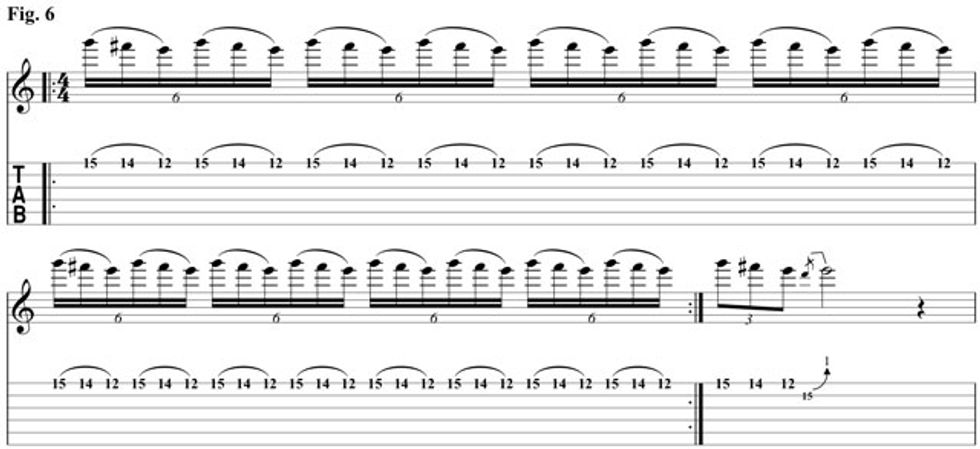Chops: Intermediate
Theory: Intermediate
Lesson Overview:
• Create blazing pentatonic licks
that shun the disco era.
• Learn how to add the 9th to a
pentatonic scale.
• Outline the sound of a chord
without ever hitting the root.
It was 1979. I was 12 years old, and Van Halen II was my favorite album. This amazing record did not contain any disco music, but the photos on the inner sleeve still showed the influence of disco fashion. Let’s just say that a stripy pair of bellbottoms is still a pair of bell-bottoms.
Musically, this record—and it’s legendary predecessor Van Halen I—set in motion a trend of guitar playing that, even several decades later, I am only just recovering from. Eddie Van Halen’s playing, tone, and attitude changed the standards and expectations of what a rock guitarist should be and should sound like. Almost overnight, the classic guitar phrases of the ’60s and early ’70s were deemed unhip. This revolution of guitar style engulfed me. I developed a sharp intuition for which guitar phrases and sounds were passé and which were cool and cutting-edge.
Decades passed, and at some point it occurred to me to revisit some of those lost licks of the ’70s. It was very much like looking at a pair of bell-bottom pants and thinking, “You know, those are actually pretty cool.”
I want to begin our trip back in time and fashion with the chunky, picked, pentatonic lick in Fig. 1. I’ve heard some version of this phrase in songs by Molly Hatchet, Kiss, Scorpions, and Triumph. I feel that it’s really a lost gem. So by all means, let’s un-lose it. Now, I want to add some more color by including the 9th, as in Fig. 2. This makes the fingering and picking a little trickier, but including some hammer-ons and pull-offs helps me glide through.


My first job as a guitar teacher was in 1985, so a large percentage of my students were into bands like Dokken, Ratt, Van Halen, and Yngwie Malmsteen. The glorious Jimmy Page-style pentatonic licks had been pushed aside. These techniques were sorely missing from the playing of the average metal kid of the era. Please check out the descending E minor-pentatonic pattern in Fig. 3 to make sure you’ve got it securely in your musical tool belt. It’s a good one. Just like before, adding the 9th in Fig. 4 gives more flavor to the sound. Finally, in Fig. 5 we try this pattern with our A13 sound.



For me, it feels very liberating to play these licks that were once forbidden. Every passing musical trend breaks some rules and constructs some new ones. And the more time that passes makes me realize that I’d rather play my guitar without worrying about style or coolness. I just want to play.
So let’s keep playing.
I’ve saved the easiest for last. This three-note phrase in Fig. 6 makes me want to grow a bushy mustache, wear a light-brown fringed leather jacket, lean my head back, close my eyes—all while wearing some serious pre-disco bell-bottoms. This lick was awesome in the late ’60s, forbidden in 1979, and now, you are the judge.

 Paul Gilbert purposefully began playing guitar
at age 9, formed the guitar-driven bands Racer
X and Mr. Big, and then accidentally had a No.
1 hit with an acoustic song called “To Be with
You.” Paul began teaching at GIT at the age of
18, has released countless albums and guitar
instructional DVDs, and will be remembered as
“the guy who got the drill stuck in his hair.” For
more information, visit paulgilbert.com.
Paul Gilbert purposefully began playing guitar
at age 9, formed the guitar-driven bands Racer
X and Mr. Big, and then accidentally had a No.
1 hit with an acoustic song called “To Be with
You.” Paul began teaching at GIT at the age of
18, has released countless albums and guitar
instructional DVDs, and will be remembered as
“the guy who got the drill stuck in his hair.” For
more information, visit paulgilbert.com.










![Rig Rundown: Russian Circles’ Mike Sullivan [2025]](https://www.premierguitar.com/media-library/youtube.jpg?id=62303631&width=1245&height=700&quality=70&coordinates=0%2C0%2C0%2C0)





